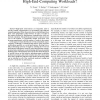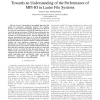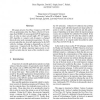CLUSTER
2008
IEEE
14 years 6 months ago
2008
IEEE
—Scientific simulation and modeling often aid in making critical decisions in such diverse fields as city planning, severe weather prediction and influenza modeling. In some o...
CLUSTER
2008
IEEE
14 years 6 months ago
2008
IEEE
—High-speed interconnects are frequently used to provide scalable communication on increasingly large high-end computing systems. Often, these networks are nonblocking, where the...
CLUSTER
2008
IEEE
14 years 6 months ago
2008
IEEE
—A commodity personal computer (PC) can be seen as a hybrid computing system equipped with two different kinds of processors, i.e. CPU and a graphics processing unit (GPU). Since...
CLUSTER
2008
IEEE
14 years 6 months ago
2008
IEEE
—Lustre is becoming an increasingly important file system for large-scale computing clusters. The problem, however, is that many data-intensive applications use MPI-IO for their ...
CLUSTER
2008
IEEE
14 years 6 months ago
2008
IEEE
This paper presents Two-Phase Compressed I/O (TPC I/O,) an optimization of the Two-Phase collective I/O technique from ROMIO, the most popular MPI-IO implementation. In order to r...
CLUSTER
2008
IEEE
14 years 6 months ago
2008
IEEE
—In this paper, we describe a whole-system live migration scheme, which transfers the whole system run-time state, including CPU state, memory data, and local disk storage, of th...
CLUSTER
2008
IEEE
14 years 6 months ago
2008
IEEE
— Applications raising in many scientific fields exhibit both data and task parallelism that have to be exploited efficiently. A classic approach is to structure those applica...
CLUSTER
2008
IEEE
14 years 6 months ago
2008
IEEE
—The current trend in clusters architecture leads toward a massive use of multicore chips. This hardware evolution raises bottleneck issues at the network interface level. The us...
CLUSTER
2008
IEEE
14 years 6 months ago
2008
IEEE
Abstract—The Special PRiority and Urgent Computing Environment (SPRUCE) provides on-demand access to highperformance computing resources for time-critical applications. While SPR...
CLUSTER
2008
IEEE
14 years 6 months ago
2008
IEEE
—The industry is now in agreement that the future of architecture design lies in multiple cores. As a consequence, all computer systems today, from embedded devices to petascale ...




